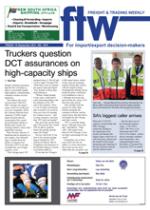Doing business in the Eastern
Cape is tough – and the
hardest part often is breaking
through the loser perception
many of the province’s
people have in themselves,
their businesses and their
prospects.
Those who ignore the
pessimism and look for
opportunities usually find
that the province has much
to offer – particularly those
involved in logistics and
transport.
For a start, the province
has three ports.
Business in Port Elizabeth,
in particular, has not grasped
the trading and value-adding
opportunities created by
having two ports that connect
the city to the world and the
rest of Africa.
One of the companies
to seize the opportunity is
General Motors, which has
established a parts warehouse
in the Coega IDZ to serve
Africa, and will be building
an Isuzu bakkie designed for
the African market.
Transnet is coming under
increasing pressure to also
invest in East London, and
some movement can be
expected there.
Additional volumes
Votes aside from an
increasingly restive ANC
electorate, the “business
case” for investment in the
port is being provided by
additional volumes expected
through the Mercedes
Benz plant, coal exports
(from the Elitheni mine
near Indwe at the centre of
the province), and moves
to boost agricultural and
manufacturing output in the
Border region.
Ports, of course, need to be
connected to markets through
road and rail links.
A billion rand is being
invested in the province’s
secondary roads during the
current financial year as part
of the government’s S’hamba
Sonke – “Moving Together”
roads infrastructure upgrade
and maintenance programme.
The Minister of Water and
Environmental Affairs, Edna
Molewa, has approved and
given the go-ahead for the
construction of the N2 Wild
Coast Road. Costing
R8 billion to R10 billion,
the new tolled route will
effectively shorten the
distance between East
London and Durban by 85
kilometres and open up the
Wild Coast for development.
Upgrades and repairs are
also under way on most of the
major routes.
Rail links
There is also intense lobbying
for Transnet to upgrade the
rail links to the province’s
ports.
On the Port Elizabeth route,
the focus is on manganese
exports from mines in the
Northern Cape. Currently
the line serves the main
manganese export terminal
through the port of Port
Elizabeth, which is due to be
decommissioned in 2017.
If the volumes of
manganese move to Saldanha
– which is reportedly
preferred by the big mining
companies – the rail link will
effectively be downgraded to
branch line status.
This will be a blow for
the Kalagadi group which
is planning to build a
320 000-ton-a-year
manganese smelter in the
Coega IDZ.
Due to be operational by
2013, the smelter will be one
of the biggest of its kind in
the world.
Any downgrade of the line
would also affect prospects
for Coega, which was
established to create jobs in a
metro where unemployment
runs as high as 75% in some
townships – a situation which
neither the ruling party nor
the private sector can allow
to persist.
Air links a challenge
Air links remain a challenge,
with the Airports Company
investing R98 million in East
London, and R68 million in
Port Elizabeth to spruce up
facilities ahead of the World
Cup, but doing nothing to
extend the runways to take
direct international flights.
But, overnight road links
to the Gauteng hub at OR
Tambo provide a cheaper and
often more reliable option for
perishable and other freight
exports.
There’s more, but the point
is that opportunities abound
– you just wouldn’t think so
talking to the average Eastern
Caper.
A province of promise – and some delivery
16 Sep 2011 - by Ed Richardson
0 Comments
FTW - 16 Sep 11

16 Sep 2011
16 Sep 2011
16 Sep 2011
16 Sep 2011
16 Sep 2011
16 Sep 2011
16 Sep 2011
16 Sep 2011
16 Sep 2011
16 Sep 2011
Border Beat
Poll
Featured Jobs
New
